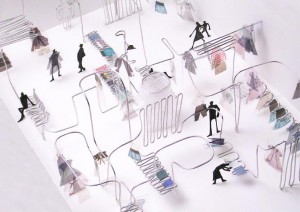Case Study: Moriyama House / Ryue Nishizawa
Reading Text: Cooking, Yo-ing, Thinking / Sanford Kwinter
The Moriyama House which is participated in Tokyo Metropolitan area, is different from other houses by spreading on site. It is properly a fractal house. It has numerous of bedrooms, dining rooms, living rooms, study rooms and they are all spread over in the site; not in a particular point as a known house. Each group of rooms has different size and characters which can provide various alterations between rooms. For instance; having a sky view from top or being surrounded by garden offer different lifestyles in rooms. Additionally, it is a good advantage that the rooms have independency and privacy by staying away from each other.
The Moriyama House demonstrates positional relation from Relational Logics, due to the different locations of rooms in side. It is important that the various situations and proportions of rooms are related to each other and they provide integrity. Otherwise, the house has an intangible and disturbed relation due to the blurred boundary between inside-outside. You can walk through the path way from one room to another room, but you are already out of the room. It gives a chance to get experience of being outside and inside at the same time. The certain boundary between interior and exterior disappears with the Moriyama House. Disturbing the natural elements can give good results.
With ‘Cooking, Yo-ing, Thinking’, it is clear that Kwinter emphasizes the Digital Environment which provides us having connections and relations with nature in digital way. Kwinter’s text is about a relation between humankind and perceiving the nature. He explains how we present the nature with computers. . In this way, we are all a part of nature, we can not be considered by standing apart from nature. As in twentieth century, it is explicit that we are full of tools and the computers are one of the tools. As an aside, the computers are not just tools; they are more than a ‘tool’. Thanking to computers, we are representing reality and nature in a better manner. Computers change the way we think. We can able to understand the environmental movement; and even we can know everything by computers. We can perceive how the nature works. Now computers help us to know more than nature.
Last but not least, each environment has own characteristics. By computers, we can combine the natural, social and digital environment. Kwinter states that the digital tools should be in hence with architecture.
‘The Architecture’ goes beyond the conventional. Recently, it is getting more complex and integrated with its surroundings and environment. In consequently, I am interested in the relation between the buildings and the environment. They are all interacted, they can not be considered separately. The possible topic that I would like to develop in the future is the reasons of changing the boundary of environment. It will help me to perceive how architecture improved fast based on the requirements of changes in the world and be conscious of what will be in the future.

